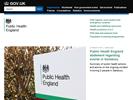WebMD - Better information. Better health.
Source for health and medical news and information. Providing credible health information, supportive community, and educational services by blending award-winning expertise in content, community services, expert commentary, and medical review.
webmd.com
- 439
National Institutes of Health
nih.gov
- 440
Agency for Healthcare Research and Quality (AHRQ)
ahrq.gov
- 441
Arthritis and Musculoskeletal Interagency Coordinating Committee
niams.nih.gov
- 442
Health Resources and Services Administration
hrsa.gov
- 444
Indian Health Service
ihs.gov
- 445
Uniformed Services University of the Health Sciences
usuhs.mil
- 449
U.S. Department of Health and Human Services (HHS)
hhs.gov
- 453
Agency for Toxic Substances and Disease Registry
atsdr.cdc.gov
- 455
National Council on Disability
ncd.gov
- 457
Medicare Payment Advisory Commission
medpac.gov
- 460




















